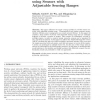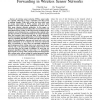15 search results - page 2 / 3 » Improving partial cover of Random Walks in large-scale Wirel... |
IJSNET
2006
13 years 4 months ago
2006
Abstract: This paper addresses the target coverage problem in wireless sensor networks with adjustable sensing range. Communication and sensing consume energy, therefore efficient ...
INFOCOM
2011
IEEE
12 years 8 months ago
2011
IEEE
A simple random walk (SRW) has been considered as an effective forwarding method for many applications in wireless sensor networks (WSNs) due to its desirable properties. However...
INFOCOM
2009
IEEE
13 years 11 months ago
2009
IEEE
—Tracking of movements such as that of people, animals, vehicles, or of phenomena such as fire, can be achieved by deploying a wireless sensor network. So far only prototype sys...
GLOBECOM
2010
IEEE
13 years 2 months ago
2010
IEEE
In wireless sensor networks (WSNs), sensor nodes are typically subjected to energy constraints and often prone to topology changes. While duty cycling has been widely used for ener...
GISCIENCE
2008
Springer
13 years 6 months ago
2008
Springer
Movement patterns, like flocking and converging, leading and following, are examples of high-level process knowledge derived from lowlevel trajectory data. Conventional techniques...


